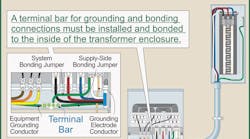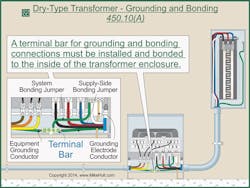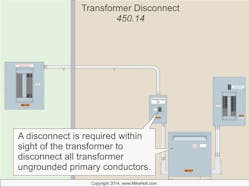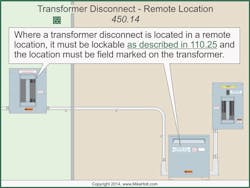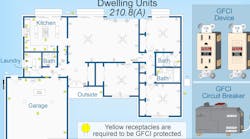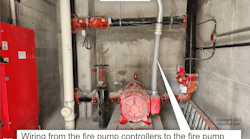This article is based on the 2014 Edition of the National Electrical Code (NEC).
All you wanted to do was install a 30kVA, 120/208V transformer to supply receptacles in a new office structure on the production floor. The plant manager is adamant about complying with the NEC, so you turned to Art. 450. Not only does it take up eight pages, but it also looks like it could be a mind-bender because it starts off by listing eight exceptions to its scope.
The good news is this situation isn’t as bad as it seems at first glance. Before we look at a strategy for making short work of this long text, let’s address those eight exceptions. We’ll also look at some changes from the previous edition of the (2011) NEC, and we’ll look at one of the major concerns with transformers.
Change
The 2014 NEC introduced some changes to the requirements for transformers. For example, now each dry-type transformer must have a place to terminate conductors [450.10(A)]. When you consider the number of green and bare wires that are typically found in a transformer, it’s really a wonder that this rule hasn’t been in the NEC for 100 years.
The raceway containing the primary conductors supplying the transformer typically contains an equipment grounding conductor as well. Included with the secondary conductors, you’ll find a supply-side bonding jumper. There will (typically) be a system bonding jumper inside the transformer. There will also be (typically) a grounding electrode conductor in the transformer. Wouldn’t it be nice if there were a place to terminate these wires? Now there has to be.
Where separate equipment grounding conductors and supply-side bonding jumpers are installed, a terminal bar for these conductors must be installed inside the enclosure. The terminal bar must not cover any ventilation openings (Fig. 1). But there is an exception: Where a dry-type transformer is equipped with wire-type connections (leads), you don’t have to install that terminal bar.
Another change is that the nameplate requirements for transformers are now in a list format [450.11(A)]. A simple side-by-side comparison of the 2011 and 2014 editions of this section will convince nearly anyone that lists are better than long paragraphs.
Transformers must have a nameplate that provides the following information:
- Name of the manufacturer.
- Rated kilovolt-amperes (kVA).
- Frequency.
- Primary and secondary voltage.
- Impedance of transformers 25kVA and larger.
- Required clearances for transformers with ventilating openings.
- Amount and kind of insulating liquid where used.
- For dry-type transformers, the temperature class for the insulation system.
New with the 2014 NEC is the text regarding secondary voltage-supplied transformers. A transformer can be supplied at the secondary voltage as long as the manufacturer’s instructions permit that arrangement [450.11(B)].
Many people don’t realize that transformers are suitable to be supplied at the secondary voltage only if the transformer is marked for this application. For example, a transformer that’s marked as 480V primary, 208V secondary can’t be wired with a 208V primary and 480V secondary. According to UL 1561, only transformers marked in this manner can be installed this way.
The 2014 NEC also revised the allowance for having a transformer disconnect remote from the equipment. The reason for this change was to achieve consistency with similar NEC rules. In this case, the Code Making Panel added the new Sec. 110.25. This section contains the rules for disconnecting means that aren’t within sight of their equipment. By referring to it, we no longer have different rules that cover the same thing spread throughout the NEC.
Keeping your cool
The prevention of overheating is a major concern with transformers. Overheating means an efficiency loss, but if the heat gets bad enough, the transformer will fail — maybe even catastrophically. While the NEC does mention that you shouldn’t do something such as orient a dry-type transformer so its vent is facing a wall only inches away [450.9], you don’t get a whole lot more than that regarding the many heat-related issues that affect transformer installation decisions.
So much of what it takes to “get it right” with transformers simply is not mentioned. Why doesn’t the NEC completely address these issues?
The reason is the scope of the NEC. Article 90 explains that the NEC isn’t a design manual. It assumes the person using it has a certain level of expertise. Proper transformer selection is an important part of preventing a transformer from overheating, and the NEC assumes you have the expertise (or someone in your company does) to correctly select the right transformer for the application.
When it presents the installation requirements, the NEC assumes you’ve already selected a transformer suitable to the load characteristics. For the NEC to tell you how to do that would push it into the realm of a design manual and/or engineering tutorial.
However, Art. 450 picks up after those kinds of “you should already know this” issues. It takes you to the next logical step by providing requirements for overcurrent protection and the proper connections. Then it goes on to provide ventilation requirements [450.9] and accessibility requirements [450.13]. At this point, you’re at the end of Part I. Now you can think of a strategy for quickly finding the requirements relevant to your particular installation.
Finding exactly what you need
So how do you get to the requirements you need for your particular installation? Part I of Art. 450 contains the general requirements such as guarding, marking, and accessibility. Requirements for autotransformers and ties are also in there. Part II contains the requirements for different types of transformers. Part III covers transformer vaults.
In the dry-type transformer example we gave at the outset, you’re not using a transformer vault. So you can ignore Part III. It’s not an autotransformer, and you aren’t doing ties — so you can skip a big chunk of Part I. But Part II still has quite a few requirements.
The key to Part II is realizing all of the requirements are arranged by type of transformer. That means each subsection is exclusive to a particular transformer type. The sole exception to this pattern is the final subsection [450.28] of Part II, which addresses what you must do if you change the type of transformer.
When you’re trying to find the applicable requirements for your transformer, you can look at the headings in Part II. For your 30kVA 120/208V transformer, you’re in luck. because right away you see 450.21 addresses dry-type transformers installed indoors. Even luckier for you, subsection (A) is for those not greater than 112.5kVA. You can ignore the rest of Part II.
But what if you were installing an askarel-filled transformer indoors? You would skip right past 450.21 and 450.22, which both address dry-type transformers (installed indoors and outdoors, respectively).
Don’t use this shortcut with all NEC Articles. It works in this special case and with a few other Articles. With some Articles, you can’t cherry-pick this way without missing something important. It just so happens you can do that when trying to determine the requirements for transformers.
Holt is the owner of Mike Holt Enterprises, Inc. in Leesburg, Fla. He can be reached at www.mikeholt.com.
